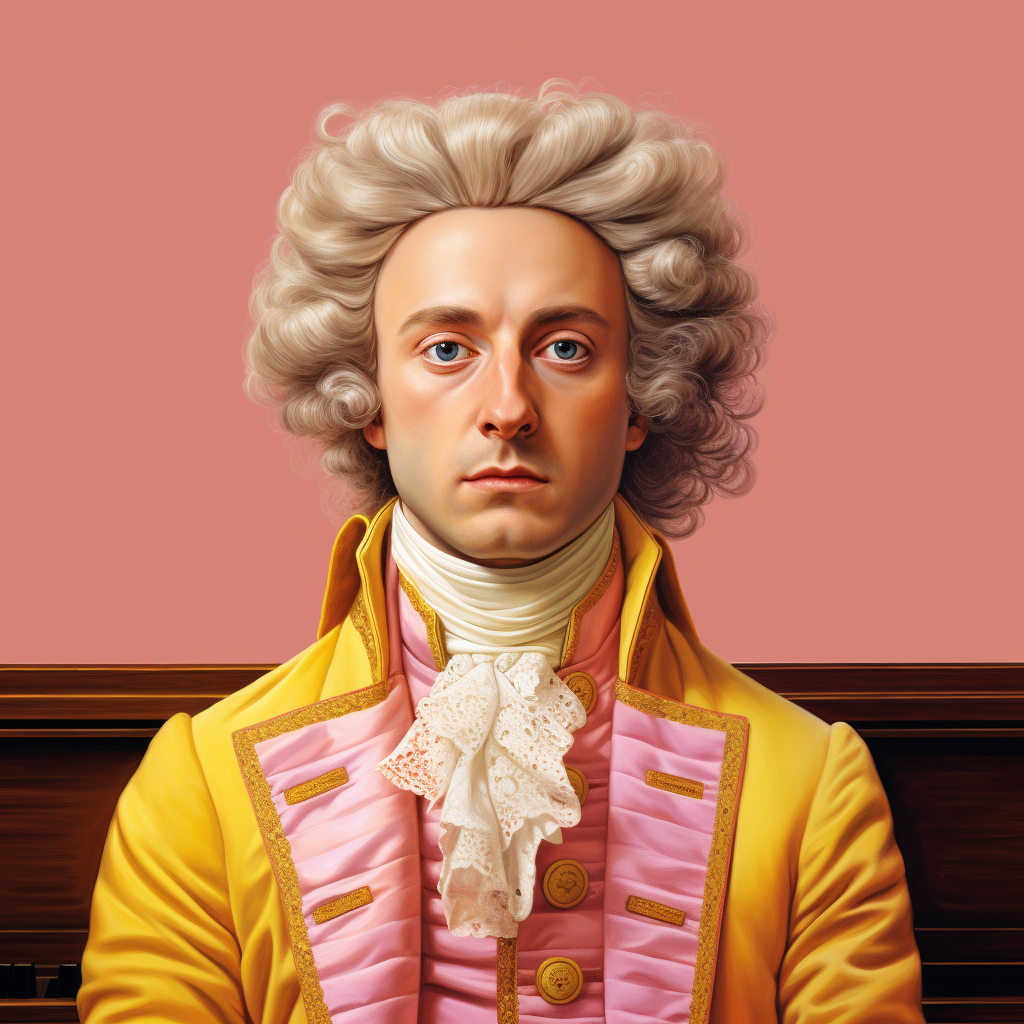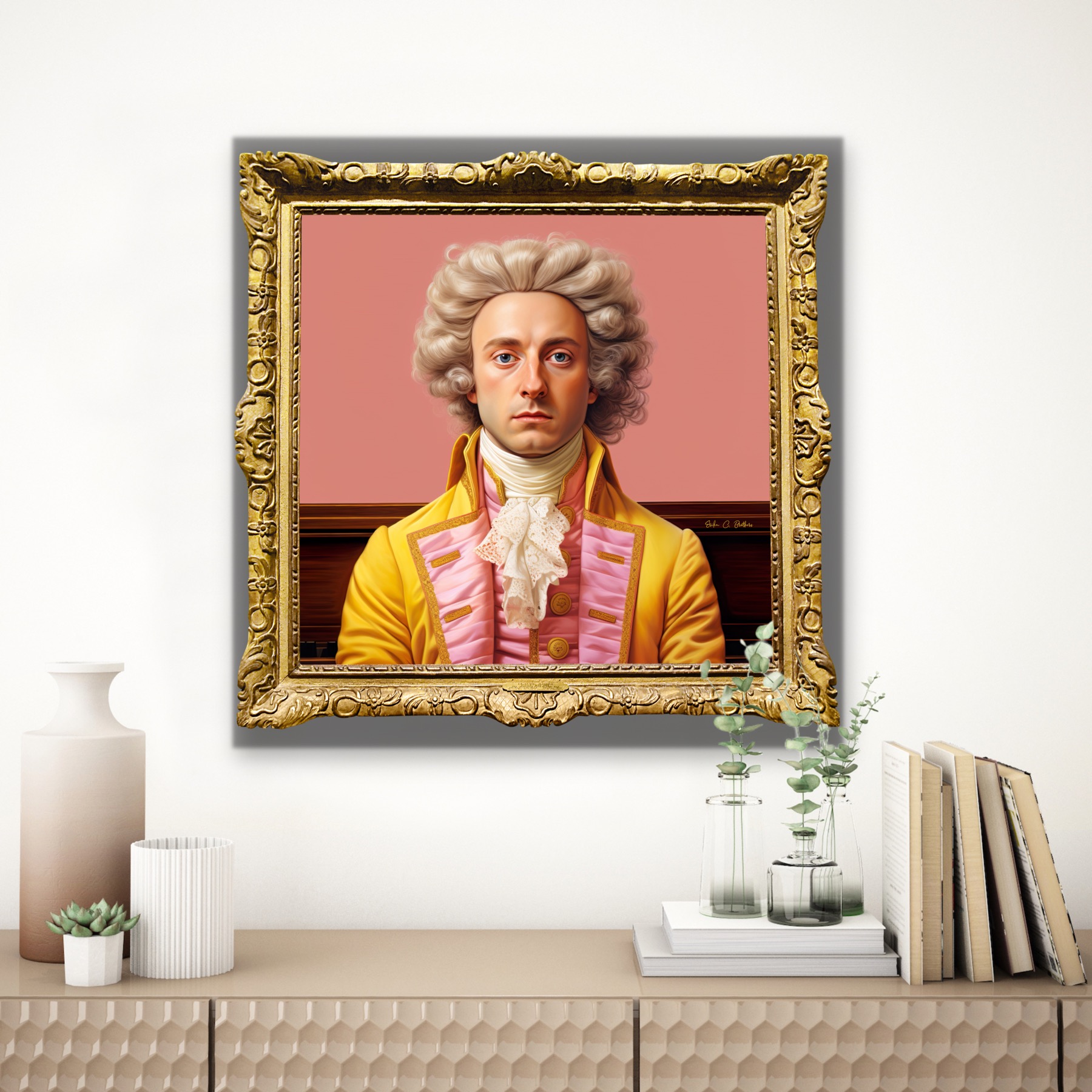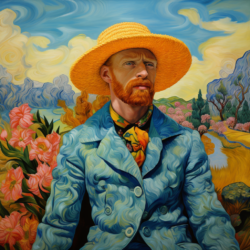Mozart Pop Culture AI Portrait
$46.00 – $883.00
Introducing my Technology AI Art category! As many know, I constantly look for new ways to create art and tell a story through visualization. Today something new for all you tech lovers and those interested in the next generation of imagination and creativity based on AI! A strange technological collaboration between AI, my thought creation, and my inner me.
Check out the new line and creations!
The Future is here, but the past will always be present
The image presents a modern and detailed interpretation of Wolfgang Amadeus Mozart, the legendary composer known for his profound impact on classical music. The portrait is a fusion of classical portraiture and contemporary digital art, capturing Mozart in a way that feels both historically accurate and visually striking.
Mozart is depicted with a dignified and serene expression, his gaze direct and slightly introspective. His features are rendered with precision, highlighting the composer’s youthful face and clear, intelligent eyes that seem to convey a deep connection to the music he created. The softness of his skin contrasts with the sharpness of his gaze, creating a balance between the innocence of youth and the seriousness of genius.
His hair, styled in the elaborate manner typical of the 18th century, is a light, almost platinum blonde, curled and voluminous. The wig or hair style, meticulously crafted, reflects the fashion of his time, with each curl and wave carefully rendered to give a sense of texture and realism. The hair frames his face, adding an air of elegance and sophistication that befits his status as a musical prodigy and court composer.
Mozart’s clothing is a vibrant display of the fashion of his era, with a coat that immediately draws the eye. The coat is a rich, golden yellow, a color that suggests wealth, creativity, and the bright, lively nature of his compositions. The fabric appears luxurious, with a subtle sheen that indicates fine material, possibly silk or satin. The coat is adorned with pink accents, including trim and buttons, which add a playful contrast to the otherwise stately attire.
Underneath the coat, Mozart wears a high-collared white shirt, tied at the neck with an intricate lace cravat. The lace is detailed and delicate, a symbol of refinement and the attention to detail that characterized both his personal style and his musical compositions. The cravat, a key element of 18th-century fashion, adds a touch of elegance and formality, reinforcing Mozart’s position as a respected figure in the courts of Europe.
The background of the portrait is a solid, muted pink, a choice that is both modern and subtly reflective of the pastels often used in portraits of the Rococo period. This background color complements the vibrancy of Mozart’s clothing while allowing his figure to stand out prominently. The simplicity of the background ensures that the viewer’s focus remains on Mozart himself, without any distractions.
Behind Mozart, a piano or harpsichord is subtly suggested, its dark wood providing a contrast to the light tones of his attire. This inclusion serves as a reminder of his prodigious talent and lifelong connection to music. The instrument, though not fully visible, is an integral part of the composition, anchoring Mozart in the world of music that defined his life.
The overall composition of the portrait is balanced and harmonious, much like Mozart’s own music. The choice of colors, the attention to detail in his attire, and the expression on his face all work together to create a portrayal that is both respectful of historical accuracy and infused with a modern sensibility.
In essence, this image of Mozart captures the essence of the composer not just as a historical figure, but as a timeless icon of creativity and genius. The combination of classical and contemporary elements in the portrait reflects the enduring relevance of Mozart’s work, which continues to inspire and influence musicians and listeners around the world. Through this portrait, Mozart is presented not just as a figure of the past, but as a vibrant, living presence whose legacy transcends time.
The artist’s use of color, light, and detail all contribute to a portrayal that is rich in symbolism and meaning, offering a glimpse into the character of one of history’s greatest composers. This image serves as a fitting tribute to Mozart, honoring both his musical brilliance and his lasting impact on the world of art and culture.
| FrameSize | 8×8 inches (20×20 cm), US and Mexico, 10×10 inches, US only, 11×11 inches, US only, 12×12 inches (30x30cm), US and Mexico, 16×16 inches (40×40 cm), Mexico only, 20×20 inches (50×50 cm), US and Mexico, 24×24 inches (60×60 cm), US and Mexico, 28×28 inches (70×70 cm), Mexico only, 30×30 inches, US only, 32×32 inches (80×80 cm), Mexico only, 36×36 inches (90×90 cm), Mexico only, 40×40 inches (100×100 cm), US and Mexico, 47×47 inches (120×120 cm), Mexico only |
|---|
Related products
AI ART
AI ART











